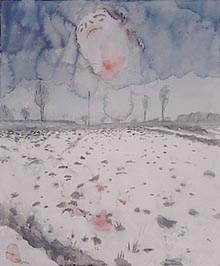
With the exception of Joseph Beuys, Anselm Kiefer is the postwar German artist who most directly confronts the Nazi past. A strangely seductive figure who plays visceral, taboo-breaking games, he refuses to simply sterilize or denature Nazi imagery. Instead, he boldly enters – mucks about in – the dirty space that lies between the great German Romantics and their horrifying Nazi offspring. His way of facing the Nazi past particularly interests Americans, who were early and avid collectors of his art. In 1995, the Metropolitan Museum of Art bought a collection of Kiefer’s works on paper, mostly from the seventies and eighties, which the artist had kept together as a corpus. Using this collection as a starting point, Nan Rosenthal has now organized a show – Anselm Kiefer: Works on Paper 1969-1993 – that displays Kiefer’s restless, confrontational approach to German culture.
An early watercolor from 1970, Winter Landscape, anticipated many of the themes that would later obsess this artist. The image shows a stark, pockmarked field – possibly a battlefield – in which the virginal snow is stained by mud from below and blood from above. The blood drips from a mortal neck wound in the floating, ethereal head of a young woman. She is part of the sky; she could be one of the mythic maidens of German culture. The watercolor looks at once earthbound and dreamy: The sacrifice of purity must be felt in both the mind and the fingers. Kiefer would become best known in succeeding years for making bleak paintings of the German landscape (the land, of course, being a resonant Romantic and Nazi theme) that included bits of straw and actual hunks of dirt – as if the great German romance with the land could no longer remain an illusion but must now be literally rubbed in the viewer’s eyes.
More than most of his contemporaries, Kiefer, who was born in 1945, has developed an abstruse iconography. His drawings are never simply visual. They almost ask to be “read.” He frequently makes grandiloquent allusions to Old Norse myths; to events in German history; to Wagner; to poetry and philosophy; to Nazi architecture; to railroad tracks and the death camps. He is not timid about making use of Jewish writing: Some pictures refer to “Death Fugue” by the Romanian Jewish poet Paul Celan (1920-1970), a poem set in a death camp in which a “master from Germany” forces inmates to dig their graves to dance music. An artist who constantly mixes and matches, finding echoes between far-flung sources in German history and culture, Kiefer likes to scrawl words across images and to combine different kinds of media. In a series of black-and-white photographs that show the sky with a strip of land below, Kiefer used molten lead to create the shapes of the clouds – a darkly witty evocation of the way the fiery dreams of the sky can coalesce into the heavy burdens of the earth.
To appreciate Kiefer’s layered art, it helps to know something of German culture. (The wall labels prove useful here.) Still, Kiefer has developed a distinctive style that can also convey his meaning without words. In his drawings, for example, he will collapse together sharply contrasting sensations of scale. Open plains, deep perspectives, echoing spaces – but also jittery little passages of impasto. Or, to put it differently, grand ideas have intimate consequences. His enormous woodcuts depend upon many smaller woodcuts and upon the fine grain of the wood itself. Often, his hand is both skillful and awkward. He will draw figures in a clumsy way and make use of the cheap look of junky illustration while at the same time handling other elements, such as watercolor, elegantly. The result is that his art often looks powerfully defaced, as if a thuggish hand had suddenly entered high art. Which is what the Nazis did to German culture. Kiefer still worries about Germany. He appears determined to face down a recurring, messianic darkness that Americans hardly know. “A dictator like Hitler could say, ‘I am the leader you expected,’ ” Kiefer has said. “The idea itself that someone in the past will come again if the nation is in danger – you don’t have that in America, that Jefferson will come again or that Lincoln will reappear on Park Avenue.”